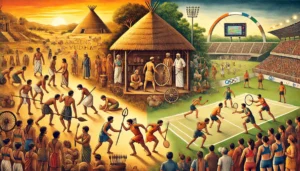
History of sports
Comparison of Ancient and Modern Sports: How Traditional Sports Have Influenced Contemporary Games
Throughout history, sports have served as a universal expression of human culture, bridging the past and present. Ancient civilizations developed games and sports to enhance physical fitness, foster camaraderie, demonstrate skills, and even perform religious rituals. Modern sports, while shaped by technology and globalization, often find their roots in these age-old traditions. This article explores the connection between ancient and modern sports, highlighting how traditional sports have evolved and influenced contemporary games.
The Origin of Sports: Ancient Practices and Their Purpose
Sports have existed since prehistoric times, evidenced by cave paintings depicting activities like wrestling and archery. In ancient civilizations, sports were often intertwined with culture, religion, and societal values.
Egyptian Sports: In ancient Egypt, sports like swimming, wrestling, and javelin throwing were popular, often linked to military training. Ceremonial competitions during festivals, like rowing on the Nile, showcased athletic prowess.
Greek Sports: Ancient Greece is synonymous with the Olympic Games, first held in 776 BCE. The games included events like discus throwing, chariot racing, and pankration (a mix of boxing and wrestling), emphasizing physical excellence and honoring Zeus.
Indian Sports: India’s history is rich with traditional sports such as mallakhamb (aerial yoga/gymnastics), kabaddi, and kushti (wrestling). These sports reflected physical, mental, and spiritual growth, deeply embedded in the teachings of Ayurveda and yoga.
Chinese Sports: In ancient China, activities like cuju (a precursor to modern soccer) and archery were practiced. These sports were associated with military training, health, and Confucian values of discipline.
Mesoamerican Ballgames: In Central America, civilizations like the Maya played ballgames like pok-ta-pok. These games often held religious significance, with outcomes linked to divine blessings or curses.
Table of Contents
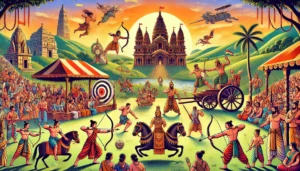
History of sports
Modern Sports: Characteristics and Evolution
Modern sports, characterized by standardization, professionalism, and global reach, are far removed from their ancient counterparts in some ways. Yet, the essence of competition, skill, and teamwork remains the same.
Technological Integration: Advances in equipment, from composite materials in racquets to AI-assisted performance tracking, have revolutionized sports. Traditional games, played with rudimentary tools, now benefit from cutting-edge gear.
Commercialization: Unlike ancient sports, which were often ceremonial or communal, modern sports have become industries. Events like the FIFA World Cup or the Olympics generate billions in revenue.
Global Accessibility: Television, the internet, and social media have made sports accessible to global audiences, creating international fanbases.
Inclusivity: While ancient sports were often restricted by class, gender, or caste, modern sports emphasize inclusivity, with platforms for women, para-athletes, and marginalized communities.
Influence of Traditional Sports on Modern Games
Ancient sports have significantly shaped modern games, either by direct evolution or through their underlying principles. Let us examine this evolution across various domains:
- Wrestling and Combat Sports
Ancient Roots: Wrestling was one of the earliest sports, practiced in ancient Egypt, India (kushti), and Greece (pankration).
Modern Evolution: Wrestling has evolved into different styles like freestyle and Greco-Roman. Martial arts such as judo and taekwondo derive from ancient combat techniques. Mixed Martial Arts (MMA) integrates multiple ancient fighting styles.
- Team Sports
Ancient Roots: Games like kabaddi in India and cuju in China emphasized teamwork and strategy.
Modern Evolution: Kabaddi is now an international sport with leagues and tournaments. Cuju is considered the forerunner of soccer, which has become the most popular sport globally.
- Track and Field
Ancient Roots: The Olympics in ancient Greece included events like running, discus throwing, and long jump.
Modern Evolution: These events remain staples in modern athletics, with enhanced techniques, equipment, and training.
- Ball Games
Ancient Roots: The Mesoamerican ballgame influenced modern ball sports. In India, traditional games like gilli-danda bear similarities to cricket.
Modern Evolution: Soccer, basketball, and cricket owe their origins to simpler, ancient ball games, albeit with structured rules and global followings.
- Gymnastics and Physical Training
Ancient Roots: Ancient India’s mallakhamb and Greece’s gymnastics showcased physical agility.
Modern Evolution: Gymnastics is now a refined sport with multiple disciplines, retaining the essence of ancient physical artistry.
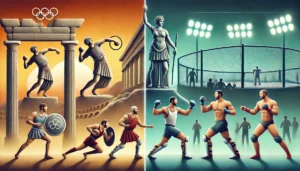
History of sports
Lessons from Traditional Sports
- Simplicity and Accessibility
Ancient sports required minimal equipment, making them accessible to all. Modern games like street soccer and basketball echo this simplicity, proving that passion for sports transcends material constraints.
- Integration with Nature
Traditional sports often utilized natural elements—rivers for rowing, fields for wrestling, and open spaces for archery. Modern sports can learn to adopt eco-friendly practices, ensuring sustainability.
- Holistic Well-being
Ancient games were often linked to holistic health, balancing physical fitness with mental and spiritual growth. Yoga-inspired sports therapy and mindfulness training in modern athletics trace back to these roots.
Challenges in Preserving Traditional Sports
As modern sports gain prominence, traditional games face the risk of extinction. Urbanization, lack of institutional support, and a focus on commercial sports have marginalized age-old practices. For example:
Mallakhamb struggles for recognition despite its rich heritage.
Indigenous games like gilli-danda are rarely played by younger generations.
Efforts are needed to preserve these traditions, including:
Government Policies: Programs like India’s Khelo India initiative aim to revive traditional sports.
Cultural Festivals: Events showcasing traditional games can generate interest and awareness.
Integration with Modern Sports: Elements of traditional games can be incorporated into contemporary formats, ensuring continuity.
Expanded Comparisons of Specific Ancient and Modern Sports
Kabaddi: From a Village Game to a Global Phenomenon
Ancient Roots:
Kabaddi, originating in ancient India, was initially a rural sport played during festivals and community gatherings. The game demanded minimal equipment and showcased physical strength, agility, and strategic teamwork. Historical references to kabaddi can be found in Indian epics like the Mahabharata, where it is said that Abhimanyu’s skill in penetrating and breaking out of a defensive formation (the Chakravyuha) mirrored kabaddi tactics.
Modern Evolution:
Kabaddi has grown into a global sport, thanks to the establishment of leagues and international competitions. The Pro Kabaddi League (PKL), launched in 2014, revolutionized the game, introducing modern formats, international players, and high-definition broadcasts. Rules were standardized, and the introduction of concepts like the “super raid” and “do-or-die raid” added excitement for spectators. Today, kabaddi is recognized by the Asian Games and played professionally in countries like Iran, South Korea, and Kenya.
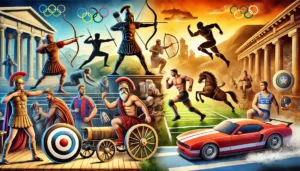
History of sports
Soccer: From Cuju to the World’s Most Popular Sport
Ancient Roots:
The Chinese game of cuju, played during the Han Dynasty (206 BCE–220 CE), is often considered the earliest form of soccer. Players kicked a leather ball through a small net without using their hands. The game was initially a form of military training before becoming a popular pastime in royal courts and among commoners.
Modern Evolution:
Soccer evolved in medieval Europe, with variations like mob football in England. The codification of rules in the 19th century by the Football Association (FA) in England transformed soccer into a structured sport. Today, soccer is governed by organizations like FIFA, with global tournaments such as the FIFA World Cup attracting billions of viewers. Technology, like VAR (Video Assistant Referee) and smart balls, has further modernized the sport while retaining its foundational spirit.
Wrestling: From Kushti to Olympic Glory
Ancient Roots:
Wrestling was a prominent sport in ancient civilizations, practiced in India as kushti or pehlwani, in Greece as pankration, and in Egypt as part of pharaohs’ ceremonies. Indian wrestling was traditionally performed in mud pits (akhadas), emphasizing discipline, diet, and spirituality. Wrestlers followed a strict regimen called vyayamshala to build physical and mental strength.
Modern Evolution:
Wrestling today is a key Olympic sport, with categories such as freestyle and Greco-Roman wrestling. India’s kushti has influenced contemporary professional wrestling, with wrestlers like the Great Gama inspiring generations. Wrestlers now compete on mats with protective gear, adhering to weight classes and global standards. Mixed Martial Arts (MMA) further combines wrestling techniques with ancient combat sports like pankration and judo.
Cricket: A Link to Gilli-Danda
Ancient Roots:
Gilli-danda, a traditional Indian game, involves a wooden stick (danda) and a small oval-shaped piece of wood (gilli). The objective is to hit the gilli with the danda as far as possible and score points by running to designated areas. Gilli-danda was a pastime in rural India, requiring no formal setup or expensive equipment.
Modern Evolution:
Cricket, though a British invention, shares conceptual similarities with gilli-danda. The idea of hitting a ball and running between wickets resembles the essence of gilli-danda. Cricket has since evolved into a highly technical game, with formats like Test matches, ODIs, and T20s. Advanced tools like Hawk-Eye for ball tracking and Snickometer for edge detection highlight its modernization. Interestingly, gilli-danda is still played recreationally in rural areas, preserving its cultural significance.
Gymnastics: Mallakhamb to Artistic Performances
Ancient Roots:
Mallakhamb, developed in ancient India, involved performing yoga poses and acrobatics on a wooden pole or rope. It was designed to enhance flexibility, strength, and balance while fostering a connection between the body and mind. The sport was a crucial part of training for warriors, improving agility and endurance.
Modern Evolution:
Gymnastics, as seen today, retains the artistic and athletic essence of mallakhamb. Artistic gymnastics, introduced in the modern Olympics in 1896, involves apparatus like parallel bars, rings, and the vault. While mallakhamb remains a niche sport, efforts are being made to integrate it into international platforms, with demonstrations at events like the Khelo India Games.
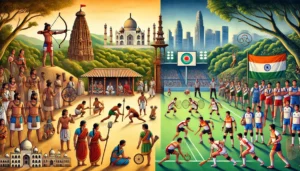
History of sports
Archery: From Ancient Warfare to Precision Sport
Ancient Roots:
Archery was integral to ancient warfare and hunting. Civilizations like the Mesopotamians, Greeks, and Indians trained archers as part of their military strategy. In Indian mythology, figures like Arjuna from the Mahabharata and Ekalavya epitomized mastery in archery.
Modern Evolution:
Archery has transitioned from a survival skill to a competitive sport, featured in the Olympics since 1900. Modern archery involves precision equipment like composite bows, stabilizers, and sight aids. Despite these advancements, traditional forms of archery, such as Japan’s kyūdō and Bhutan’s dha, continue to be practiced as cultural traditions.
Conclusion
The journey from ancient sports to modern games is a testament to humanity’s evolving relationship with competition, culture, and community. While modern sports thrive on innovation and globalization, they remain deeply rooted in traditional practices. Recognizing and preserving these roots not only honors our heritage but also enriches the global sporting culture. By blending ancient wisdom with contemporary advancements, sports can continue to inspire, unite, and elevate humanity for generations to come.
FAQs on , “Comparison of Ancient and Modern Sports: How Traditional Sports Have Influenced Contemporary Games”:
- What is the significance of traditional sports in shaping modern games?
Traditional sports laid the foundation for many contemporary games. They provided the basic rules, structure, and spirit of competition that modern sports have refined and adapted.
- Can you name some modern sports that evolved from ancient games?
Many modern sports have roots in ancient games. For example, wrestling and archery have evolved from ancient combat training, while field hockey and football (soccer) trace their origins to games like the Mesoamerican ball game and medieval mob football.
- What role did culture play in the evolution of sports?
Cultural practices and values shaped the way traditional sports were played. Over time, these games were influenced by globalization, standardized rules, and the development of international competitions, leading to their modern forms.
- How have technological advancements influenced traditional sports?
Technology has transformed traditional sports by introducing advanced equipment, safety gear, and analytics. For example, traditional stick-based games like hockey now use high-tech materials for sticks and protective gear, enhancing player performance and safety.
- What are some similarities between ancient and modern sports?
Both ancient and modern sports emphasize physical fitness, strategy, teamwork, and discipline. The core principles of fair play and competition remain consistent.
- How were sports governed in ancient times compared to now?
In ancient times, sports were governed locally by cultural or religious authorities, often without written rules. Modern sports have global governing bodies that establish standardized rules and regulations for fair play.
- Why were traditional sports often tied to religious or spiritual practices?
Traditional sports were often connected to religious rituals, festivals, or training for warfare. They served as a way to honor deities, strengthen communal bonds, and prepare individuals for physical challenges.
- What are some ancient sports that have disappeared?
Some ancient sports, like chariot racing and pankration (an ancient Greek martial art), are no longer practiced widely but have influenced modern sports like horse racing and mixed martial arts.
- What lessons can modern sports learn from traditional games?
Modern sports can learn to focus more on community engagement, sustainability, and preserving cultural heritage, aspects often emphasized in traditional games.
- How do traditional sports contribute to cultural identity today?
Traditional sports remain a vital part of cultural festivals and heritage, helping communities preserve their identity and pass on traditions to future generations.
- Are there efforts to revive ancient sports in modern times?
Yes, efforts like cultural festivals, traditional games championships, and educational initiatives aim to revive and promote ancient sports. Examples include the Olympic Games’ incorporation of wrestling and archery.
- What is the role of globalization in the evolution of sports?
Globalization has helped spread traditional sports to new regions while encouraging the blending of rules and styles, leading to the development of new hybrid games.
- How do modern sports cater to a global audience compared to traditional sports?
Modern sports are designed to be universally accessible, with standardized rules and televised events, whereas traditional sports were often localized and tailored to specific cultural contexts.
- What are some examples of traditional Indian sports that have influenced global games?
Kabaddi, yoga-inspired physical training, and Mallakhamb (a pole-based sport) have influenced modern fitness routines, while chess originated in ancient India as Chaturanga.
- How do modern sports ensure inclusivity compared to traditional sports?
Modern sports emphasize gender equality, accessibility, and inclusivity for people with disabilities, areas where many traditional sports were limited due to cultural norms.
Summary
Sports have evolved significantly over centuries, transitioning from traditional cultural practices to globally recognized modern games. Ancient sports, rooted in rituals, warfare training, or recreation, laid the foundation for many contemporary sports we see today. Activities such as wrestling, archery, and chariot racing were prevalent in ancient civilizations like India, Greece, and Rome, serving purposes beyond mere competition, including physical fitness, survival skills, and spiritual growth.
Traditional Indian sports like kabaddi, mallakhamba, and kushti (wrestling) emphasized teamwork, agility, and strength, inspiring modern versions of contact sports and gymnastic disciplines. Similarly, games like polo, which originated in Central Asia and India, evolved into an elite international sport. Globally, the Olympic Games trace their roots to ancient Greece, preserving the spirit of athletic excellence and competition.
While modern sports benefit from technological advancements, standardized rules, and global outreach, ancient sports emphasized cultural identity and communal participation. Despite these differences, many modern games retain core elements of strategy, skill, and physical endurance from their traditional counterparts. This continuity reflects how ancient practices continue to influence contemporary sports culture, ensuring their relevance across generations.
Related Articles
- “Timeless Lessons from Ancient Tales: Linking Samudra Manthan and Ganga’s Descent to Modern Ecological Challenges”
- “Reviving Sanskrit: How AI is Preserving Ancient Languages for the Future”
- “Mathura: The Sacred Land of Lord Krishna’s Divine Leelas”
- Investing for Future Generations: Lessons from Indian Traditions on Legacy Building and Wealth Preservation
- “Ancient Indian Wisdom: Timeless Lessons for Tackling Today’s Climate Crisis”
- “Artificial Intelligence and Spirituality: Transforming Ancient Practices for the Modern World”
- “Gold and Real Estate in India: Timeless Assets Shaping Financial Strategies”
- “Divine Feminine Power in Hindu Mythology: The Legends of Durga, Saraswati, and Lakshmi”
- “Divine Beings of Sanatan Dharma: The Spiritual Significance of Sacred Animals in Hinduism”
- “Symbolism in Mythological Art: Unlocking Hidden Meanings in Ancient Temple Carvings”
- “Exploring Technological Advancements in Ancient India and Civilizations: Vimana, Metallurgy, & Water Management systems”
- Unveiling the Mysteries: Ancient Temples of Sanatan Dharma , Mysterious Temples of India
- “The Scientific Knowledge of Sanatan Dharma: Ancient Wisdom Meets Modern Science”
- Ancient Indian Sports and Games: Celebrating a Legacy of Skill, Strength & Strategy”
- “Exploring the Cosmic Link: The Connection Between Astronomy and Vedic Astrology”
- The Power of Sanskrit: Unlocking the Divine Language of the Gods
- “The End of Kaliyuga: A Sanatan Insight into the World’s Final Chapter”
- Explore more articles on Prachin Sanatan Yuga.
History of sports History of sports History of sports History of sports History of sports History of sports History of sports History of sports History of sports History of sports History of sports History of sports History of sports History of sports History of sports
History of sports History of sports History of sports History of sports History of sports History of sports History of sports History of sports History of sports History of sports History of sports History of sports History of sports History of sports History of sports
